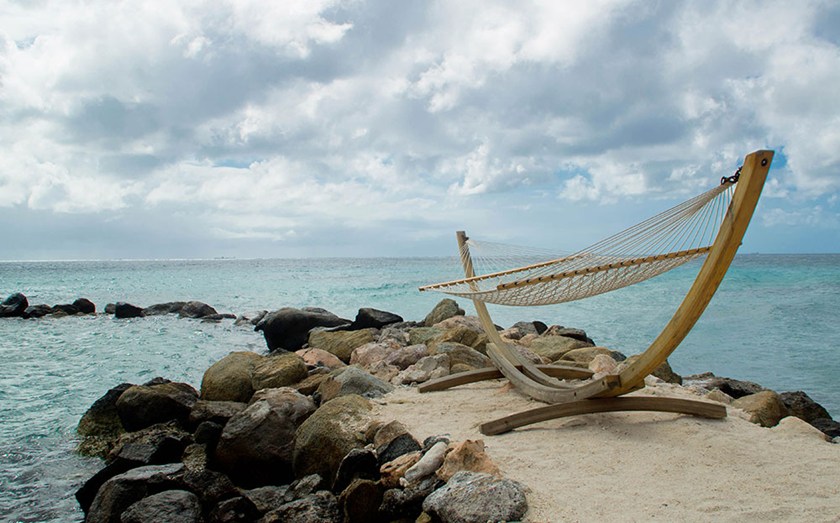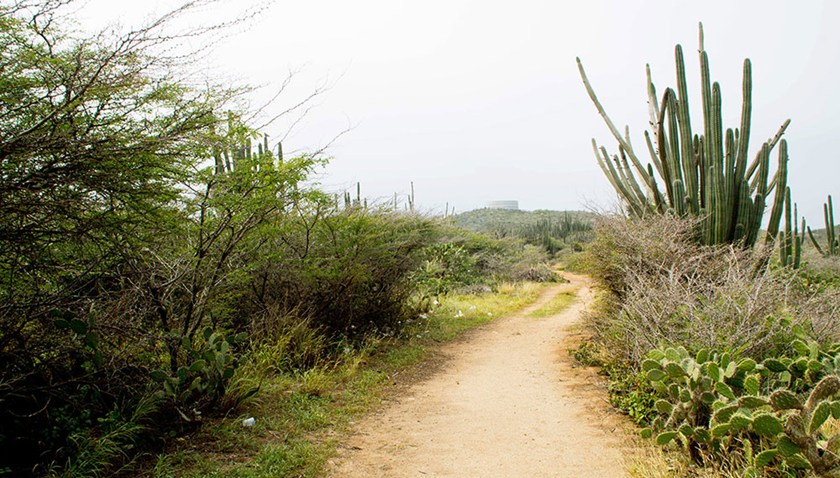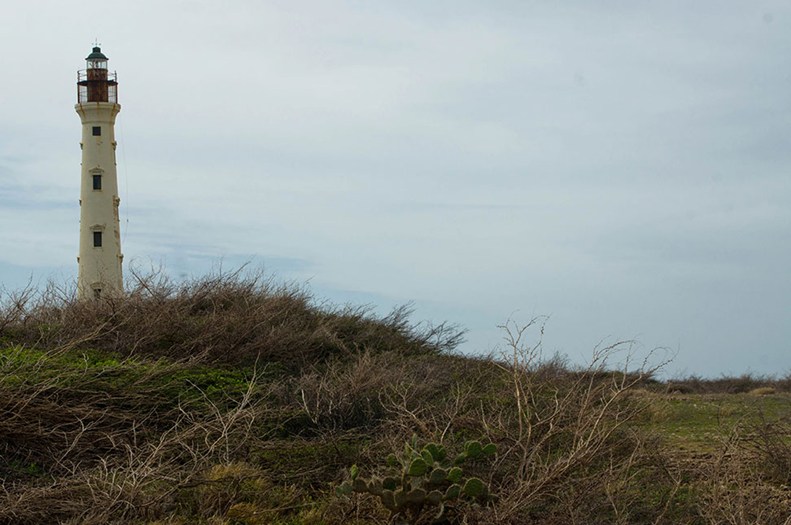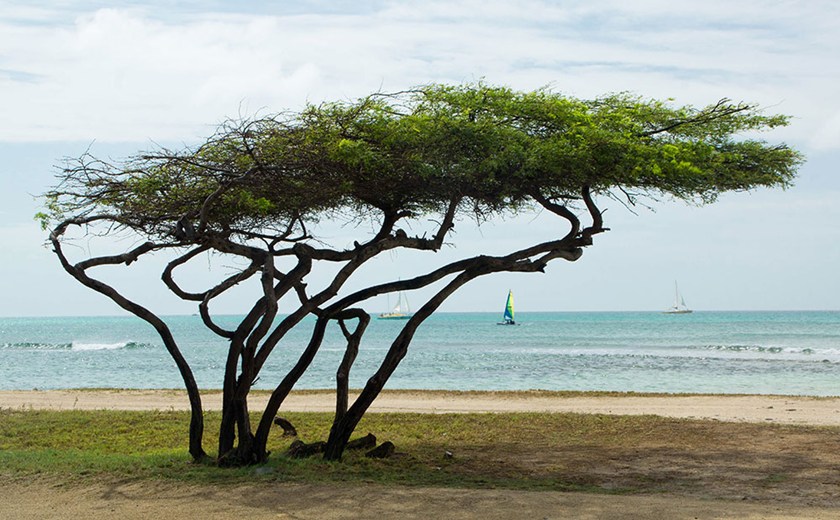ORANJESTAD, ARUBA - The Caribbean breeze is tousling my recently coiffed hair, salty water is spitting up at my face and my bleached skin is being baked by the sun. And I’m enjoying every minute of it. This is all taking place as our sail boat is heading toward glorious Eagle Beach, where we plan to spend the day dipping our toes in the turquoise surf and taking long walks along one of the best beaches in the world.
The sand here is so soft it’s like walking in flour. My feet disappear every step I take and I giggle like a little girl when the frothy waves slap against my legs.
The isolated beach is quiet in the early morning — a few people are stretched out on towels and some locals are setting up food and watersports kiosks for the crowds which always come as the day progresses.
Aruba is rich in history and has a unique landscape, with a Sahara-like desert in the interior with palm trees and enormous cacti. Gorgeous divi divi trees grow on a 45-degree angle, bent by the relentless sea breezes. Its southern coast is lined with picturesque beaches while on the opposite side of the island, giant waves, so powerful they carve natural bridges in the volcanic rock, make it too dangerous to swim there.
In recent years, Aruba has seen a tourism growth spurt. New 5-star hotels and tax-free shopping areas, as well as its atmosphere of tranquility, make it a tourist paradise.


Left: The tranquility of Aruba can't be matched. Right: The desert interior is like nothing else in the Caribbean.
There are plenty of beautiful beaches, as well as colourful neighbourhoods, with a definite South American influence (it’s very close to Venezuela) to explore. Aruba is a cultural melting-pot, displayed by its multitude of languages — Dutch, English, Spanish and the local dialect Papiamento.
It’s also home to a spicy culinary scene. I indulge in lots of Dutch treats like poffertjes (coin-sized pancakes dusted with icing sugar). Of course, the Dutch influence is everywhere. Aruba is an autonomous country in the Kingdom of the Netherlands (the head of state is the Dutch monarch) and every day lots of tourists arrive from Amsterdam.
But the locals instantly accept international tourists as their own and are quick to share the secrets of their beautiful land with strangers.
“You have to try the barbecue at the flea market on Saturdays,” one woman tells me. (It was delicious!)
A teenage boy uses his mobile phone to help me find a destination and suggests I visit the Old Cunucu House, a local restaurant specializing in Aruban dishes. (I add it to my list.)
“You need to try funchi (a crispy, polenta patty),” an elderly man tells me over morning coffee.
Arubans are proud of their capital, Oranjestad, whose colonial-style buildings are painted rainbow colours. A streetcar traverses the downtown core and the boardwalk is gorgeous by day or night. It’s especially beautiful at Christmastime when it’s decorated with colourful lights.
While exploring the capital, I come upon “pastechi” shops, which have become famous for serving up mini calzones stuffed with cheese and beef or sometimes chorizo, and even minced fish. They make a perfect two-bite snack and ignite a lively debate among locals about which is the best.
It’s hard not to gain weight on a trip to Aruba — the local cuisine and restaurants are all outstanding, especially the Old Cunucu House, where I dig into keshi yena, a casserole filled with layers of chicken, olives, vegetables, and cheese, and cabrito, Aruba’s traditional goat stew.


Left: The old lighthouses of Aruba. Right: The sea winds shape the trees in Aruba.
“This is my sister’s restaurant and these are my grandma’s recipes,” says my server, Maria. She was born in Aruba but has studied in Europe and worked in Amsterdam. But she always comes back to her island home.
My drive to Noord and visit to the landmark Alto Vista Chapel is interrupted by a 15-minute rain shower — brief showers are the norm here — and soaks us to the bone but the wind and reappearing sun quickly dry us off. The iconic little church with its ocean backdrop may be the most photographed place on the island.
On our drive back to the capital, we stop at Baby Beach where the water is shallow and we can wade out 100 metres from the shore and still be only knee-deep. It’s the perfect place to watch the glorious sunset that turns the water a bright orange.
It’s a picture that will bring back warm memories of Aruba on a cold Canadian day.
Information
How to get there: Twice a week, flights are direct from Toronto’s Pearson International Airport to Oranjestad’s Queen Beatrix International Airport. But connecting flights via Atlanta or New York are also available. Flights are daily and range from just under $1,000 (direct) or just under $600 for connecting flights via the United States. / Getting around: From the Aruba airport, shuttle buses are available for certain hotels and resorts. A taxi ride into the downtown core sets travellers back $20, while getting to the popular Palm Beach resort area costs around $30-$40. / Money: Aruba’s currency is the florin, but U.S. dollars are widely accepted across the island. Visa, Mastercard and Amex are also readily accepted. / Security: Aruba is incredibly safe. Tourists can travel on foot, take local buses, the downtown tram and rent vehicles. Some neighbourhoods, such as San Nicolas, might be better off avoided if travelling on foot. / When to go: Unlike other parts of the Caribbean, weather is consistent year-round in Aruba. The island is outside of the hurricane belt so that means there is no threat of tropical storms or monsoon season. Average daily temperatures range from 28 C to 32 C.
About the Author
Carmen Chai is an award-winning journalist who's lived and reported from major cities like Vancouver, Toronto, London and Paris. It's safe to say that Carmen has a serious case of wanderlust. She's travelled to more than 25 countries and for a plethora of reasons: hiking along Italy's Amalfi Coast, gorging on street food in Bangkok and getting lost in Istanbul's bustling streets. Along with travel writing, Carmen has reported on crime, federal politics and breaking news for major Canadian publications, including the Toronto Star.